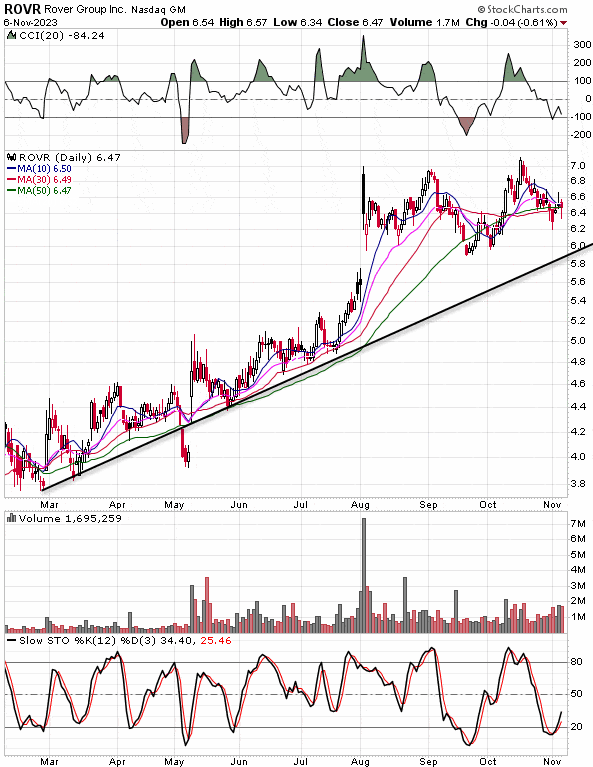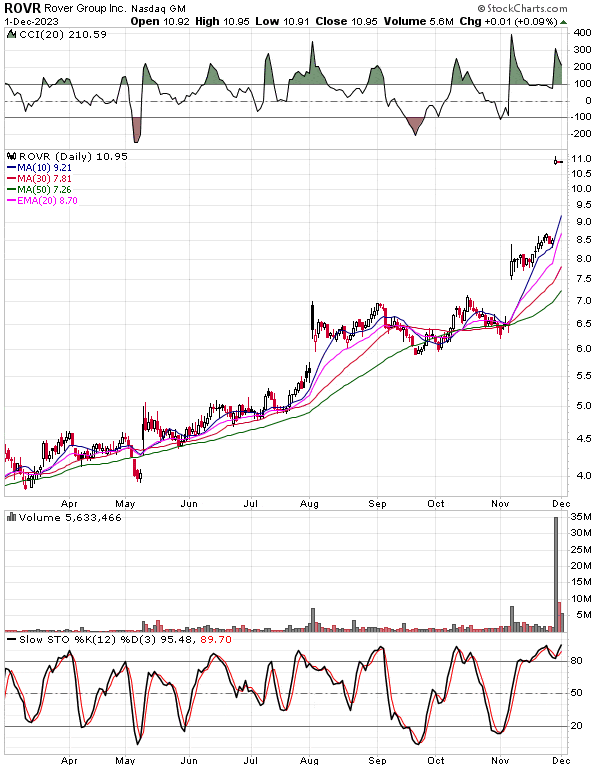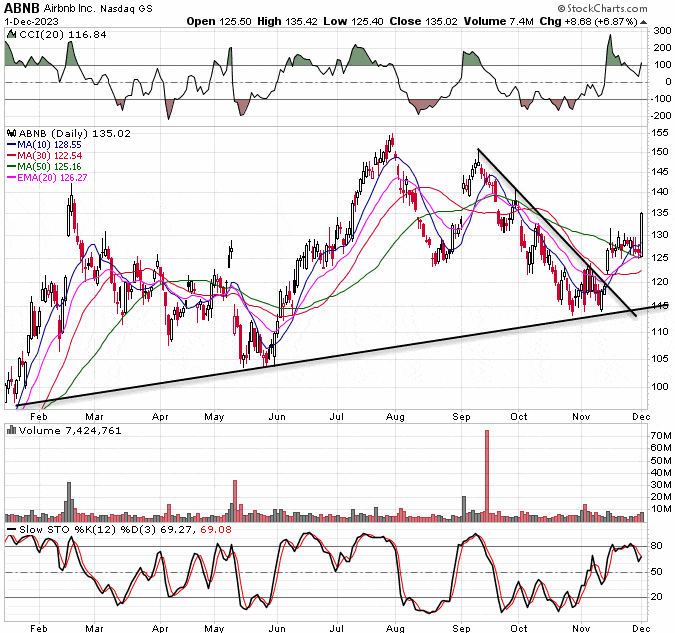What is Channeling in Trading and Is it a Good Strategy?
Over the past several months we have been talking about 3 favorite strategies we use to make money trading. The third strategy we will cover in todays blog post is called stock channeling.
After more than 15 years trading and over 10 thousand live trades testing dozens of strategies (including both day and swing trading strategies), recent blog posts have covered which ones did not work for us and the ones that worked best for us.
In the last blog post we talked about earnings flags for those who missed the biggest earnings breakouts right after a massive blowout earnings report. These earnings flags generally do poorly at the very end of November and early December due to seasonal factors but often do well overall starting around the 10th of December.
If they are not up at least 40% over the past few months from low to high, we usually take a pass on the opportunity. There are usual better ones available.
We can swing trade these earnings flags with a fresh catalyst while using a tight stop-loss.
Holiday Swing Trading Update
So far we are seeing typical early December action with more shakeouts, less consistency and lower win rates overall. One notable exception is the earnings eruptions strategy and consolidation breakouts on top stocks in long-term uptrends which was the 2nd strategy covered in a prior blog post a few months ago.
We just saw 3 big ones last week in CRM, ESTC and IOT.
Guess how many of these failed to hold a 2.5% stop-loss below the technical entry point on a daily chart before moving significantly more than 2.5% higher?
Yep, none of them. They all had pretty clean breakouts which is more typical on great stocks with powerful technical patterns above a rising 50 day and 200 day moving average.
Some of them will gap well into 52-week highs and pull back more initially but will very often hold a 2.5% stop-loss below the prior 52-week high on a daily chart if its a bullish chart pattern in a bull market. NTNX is a good example of this that came up on Wednesday evening last week.
So when the stock gaps well above the breakout point it gets a little more tricky but may be good for a longer hold on a swing trade after an initial pullback early on day 1 of the trade.
What is Channeling in Trading?
But today we will be discussing the third swing trading strategy as promised.
This strategy falls somewhere between investing and swing trading with longer hold times while using technical analysis to identify entry and exit points unlike the first strategy we covered a few months ago. This third strategy is a good opportunity to apply technical analysis to a longer-term swing trading opportunity.
Channeling in trading is just identifying stocks that are trading very consistently between a support and resistance level. For instance, a stock that is trading between $40 and $50 per share over time where the $40 support level has been tested successfully at least 3 times.
Channeling in this case is just buying near the $40 support and selling just below the $50 resistance over and over. You could even short near $50 and cover the short by buying the stock back near $40.
A stock that has found support 5 times or more is even better to show that the buyers consistently come in to overwhelm sellers around that price point.
But if we find a stock trading consistently between $40 and $50, we are talking about a horizontal channel where the overall trend is sideways.
Our Preferred Channeling Strategy
However, some channels have an upward or downward slope to them. So the overall trend is higher or lower rather than flat.
The best ones for long traders (traders looking to buy low and sell at a higher price) have an upward slope where the channel support has been tested many times for months or longer with fundamental factors improving with the overall trend. Factors such as growth in sales and earnings or earnings estimates that are trending strongly higher.
The channel support in this case is a trend line created by drawing a line connecting the lows since the trend and channel began.
We have a great video on the site on examples of a good channeling stock that has appeared in our daily alert service.
Another great example appeared in our last video covering earnings flags. This channel was the decade long upward sloping channel on Microsoft.
So How do You Find Stocks Trading in a Channel?
One good way is to look at all stocks that have at least an average of 15% per year earnings growth over the past five years. Put the list of stocks into your broker watch list and look at five year charts to find those charts where you can draw a line that roughly touches the lows over the past year or more (preferably longer) with a slope that does not outstrip the growth by too much.
We also have some in our weekly alert service. You can look at the historical archive going back over 15 years to find many of these.
We had one featured in early November that worked out really well. This trade also contains some valuable lessons we will be covering in the next blog post on how we set stop-losses.
Not only is it a channeling stock, its also a big earnings breakout. So strategy 2 also applied with this one because it has the long-term uptrend, great consolidation pattern and is reaching a good technical entry point in the pattern with a fresh catalyst. Its also one of the few stocks under $20 that are now in a strong long-term uptrend with real fundamental results that are improving rapidly.
An Exciting Channeling Stock Trade
The stock was featured in the November 6th Weekly Alert.
Here is how the chart looked back then with the channel support line added:

Charts courtesy of StockCharts.com
Sometimes we will throw out outlier moves below the support level if the stock jumps back into the channel right away. Not a great sign, but the channel support has been consistent before and after the outlier in early May. We often do this on long-term charts that include March of 2020 due to the initial pandemic shock sell-off and strong rebound right afterwards.
The uptrend support and channel does not get confirmed until around the end of May. We do not consider it a valid channel until that successful third test with a strong rebound starting after the third test.
Is Channeling Trading Profitable?
We find it most profitable when the stock finds support above the channel support and starts to move higher with very good news. The free primer video on channeling stocks discusses technical entry/exit points on the trade along with a good stop-loss.
In the case of ROVR above, the catalyst was a big earnings beat and good outlook from management.
The stock reached the entry point the next day and held a 2.5% stop below that price until it hit its target. This is the advantage of a great uptrend leading into a strong consolidation pattern and good technical entry point with a catalyst. Jump in right after earnings on most stocks without the uptrend or good consolidation pattern and things will likely not go so well.
In this case, the channeling stock had some of the best earnings estimate revisions in the market at the time. Later, the company was purchased last week. A few weeks after it appeared in the Weekly Alert.

Charts courtesy of StockCharts.com
The Advantages of This Channeling Stock Strategy
One of the advantages of focusing on stocks with rapidly improving fundamentals is that you more often run into a situation where the company gets purchased while in the trade. Not the norm but it does happen on rare occasions.
Some wonder what the real value of a stock is. Or, if its some kind of digital fairy dust from your online broker not worth anything. Then, suddenly, a company receives a buyout offer from another company and you realize that a lot of stocks are worth what they are selling for and even more.
This is especially true for stocks in a long-term uptrend with estimates rising and a track record of strong growth in sales, earnings and/or cash-flow. Why buy a failing business when some businesses are growing quickly yet reasonably priced for a good growth stock?
We find these stocks sometimes get a buyout offer and that was the case with ROVR which received an offer last week. The stock gapped over our price target and those using our entry/exit targets in the weekly alert were treated with double the target profit.
They walked away with a cool 42% within a few weeks using our price target with a limit order. Nice.
Other Examples of Channeling Stocks
Here is a special bonus this week. A stock within a shallow upward sloping channel that is not too far away from the technical entry point. Its a top growth stock potentially for the years ahead near the entry point in multiple bullish patterns as well.
The stock is ABNB.

Charts courtesy of StockCharts.com
Can you guess what other pattern is present for ABNB? If you guessed a double bottom with a low handle you would be seeing what I am seeing. The first low in the double bottom was in August and the second low in the double bottom was a few weeks ago. This shows up better on a weekly chart.
The handle has shrinking volatility which is a good sign and is part of a 1-2-3 trend change back to the upside. Now the short-term trend is in alignment with the longer-term trend which is higher as well in the upward sloping channel. We need a pullback now to get a favorable risk/reward since it was up so much on Friday.
Other Advantages of Channeling Stocks
Channeling stock trades often give you multiple entry points. Unlike breakout trades, you often do not have to “be there” when the entry point is reached. This suits traders who do not mind taking longer to build their accounts and want to take more time to analyze the trade at the entry point and do not have the time to prepare every day or just are not as disciplined.
One entry point is the close above the downtrend resistance line created by drawing a line connecting the highs in the short-term downtrend coming back to the trend-line support. Another entry point is a move above that days high the next day for more confirmation. The channeling stock video covers some of the entry points.
You also have a 1-2-3 trend change as a possible entry signal. In other words, a higher swing low followed by a higher swing high on a daily chart for more confirmation. A great entry point. (We only buy here, however, if we still have about a 1.5/1 reward to risk ratio. In the case of a big catalyst right before the stock reaches a technical entry point, such as with ROVR, we would raise our stop to ensure we have about a 1.5/1 reward to risk ratio or better.)
You also usually have time to take the trade off near the top of the channel when using this strategy. You can use a bearish candlestick pattern after nearly reaching the top of the channel, a stop-loss below the prior swing low if it breaks through the top of the channel as with ROVR, or just adjust your limit order each day to take the trade off near the top of the channel.
Have fun with it and create your own winning trading plan when channeling stocks.
How Long Channeling Trades Last
These trades can take many weeks to months to play out. So its more important to pick the ones that you are most bullish on from a fundamental standpoint. Our low cost Weekly Alert service has stocks with improving fundamentals over time.
But if you are looking to build a trading account quickly, spend the next 6 months studying and becoming skilled at trading the best high tight flag breakouts and earnings eruptions trades that meet the rules in our courses on a simulator. It takes more time, skill and cleaning up mistakes but has the potential to compound your returns more quickly in a bull market (not a bear market) as each trade almost always hits the profit target or stop-loss within a couple weeks. Usually within 3 days so you can quickly get your trading capital into the next trade.
AAOI and PRCT did not meet the rules in the high tight flag course at the point of entry last week. But even these have about a 50/50 win rate to go say 8% while holding a 5.5% stop on these lower priced stocks in a bull market.
The high tight flags that meet the course rules at the point of entry have a much higher win rate in our back-testing and our own experience trading. As a reminder, stocks under $20 have a lower win rate with this and other strategies we tested and in our own swing trading.
In Summary
So to recap, our favorite swing trading strategies include a ranking strategy to hold the top 3 stocks at all times. This is the least time consuming and takes just 1 day per week or even per month if you use a monthly re-ranking of all stocks.
The second was bullish chart pattern breakouts on great stocks in long-term uptrends with a catalyst.
And, finally, a channeling stock strategy which is great for those who want to use technical analysis while holding trades longer with usually plenty of time to get in near a good technical entry point with longer hold times of a few weeks to months or longer. In fact, you can keep a portion of a trade for years in some cases before the trend-line breaks.
Hope that helps you find the strategy that is best for you. After testing dozens of strategies, these are our favorites for new and existing retail traders alike. You can use these blog posts to develop your own killer strategy that suits you best and start proving your new hybrid strategy on a free simulator in both a bull and bear market.
Or, you can try one of our proven strategies and complete trading plans we use in our own trading such as the one below.
Learn Our Optimized, Complete Strategy Targeting Rapid Account Growth
Subscribe to our Youtube channel to be notified when our newest videos are released.




